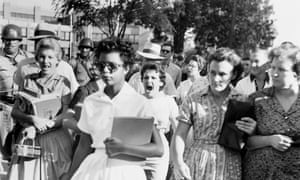
Sixty years ago school started thee weeks late in Little Rock as Gov. Orville Faubus defied the United States Supreme Court's school integration order. the image above became the an icon of white racist resistance.
But the lives of the two girls at the center of the photo - the stoic Elizabeth and the raging Hazel took an unexpected turn. Years later Hazel called Elizabeth. David Margolick tells the story of their not so easy reconciliation in his book Elizabeth and Hazel.
The day nine young students shattered racial segregation in US schools | World news | The Guardian
by David Smith
It was September 1957, the Jim Crow era of racial segregation, and nine black pupils little guessed they were about to plant a milestone in the struggle for civil rights to follow those of Emmett Till, a 14-year-old lynched in Mississippi in 1955, and Rosa Parks, who refused to give up her seat to a white passenger on a bus in Alabama later the same year.
Brown v Board of Education, the landmark 1954 supreme court ruling that segregated schools were unconstitutional, should have meant she and fellow pupils could take their places at Central High. But Governor Orval Faubus of Arkansas, in the deep south, remained defiant and used the national guard to block their enrollment. The African American children were left in limbo for three weeks.
On the first day of term, the national guard were there to stop the nine entering Central High, where all 1,900 attendees were white. Three weeks later, on 25 September, the group braved a hostile white crowd, climbed the school steps and were escorted to class by US army troops. They became known and revered as the Little Rock Nine.
Eight of the nine are still living and will return to Little Rock on Monday to mark the 60th anniversary of the US’s first major battle over school segregation. A day later, several will be in Washington to speak at the Smithsonian National Museum of African American History and Culture. It will be a moment to reflect on how far the US has come in unravelling educational apartheid – and whether, in recent years, progress has stalled or even reversed.
The share of “intensely segregated” black schools has trebled over the past 25 years, according to research by the Civil Rights Project at the University of California, Los Angeles (UCLA), which warns of a “resegregation” taking hold. One of the Black students, Minnie Jean] Trickey, who turned 76 earlier this month, asks bleakly: “What kind of country doesn’t see education for all children to be the primary value? I think the US has two values: segregation, which they do so well, and violence.”
Speaking by phone from her longtime home in Canada, she can still remember vividly the combination of segregation and violence that left her “whole body shaking with fear and shock” as a teenager six decades ago.
On 23 September 1957, the group did get into the building with police protection. But an angry mob of more than a thousand white people had gathered in front of the school, chanting racist abuse such as “Go back to Africa”.
“I really think that we were afraid to look at the mob; at least I was,” says Trickey. “So we just heard it and it was like a sports event, that sound, the roar, but it was a roar of hatred, and just thinking about it makes me shake.”****
KEEP READING

No comments:
Post a Comment